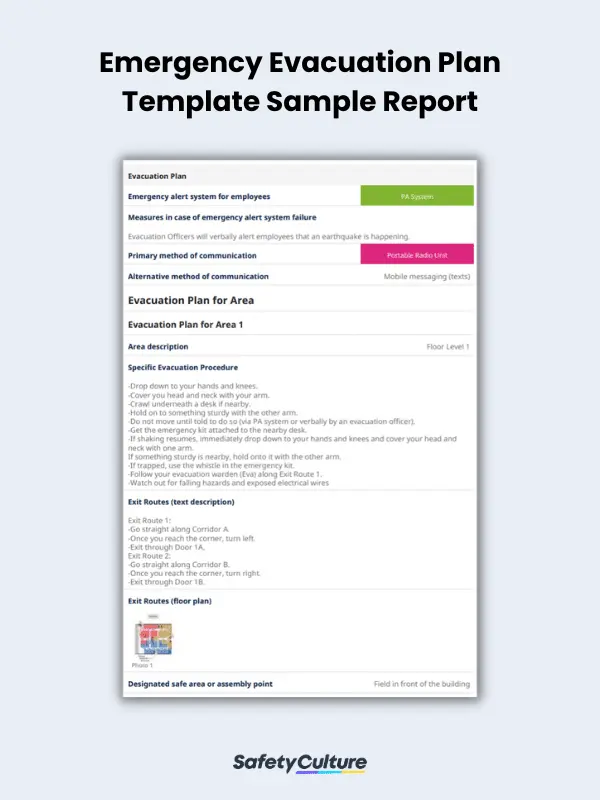What is an Emergency Evacuation Plan?
An emergency evacuation plan is a set of procedures developed by employers to help facilitate safe evacuations in case of workplace emergencies. Emergency evacuation plans usually contain exit routes, locations of designated safe areas, and the specific steps to follow for each type of emergency.
When is Evacuation Needed?
According to the Occupational Safety and Health Administration (OSHA), while any type of emergency may require an evacuation, it should still be decided on a case-by-case basis.
Conditions under which an evacuation would be necessary include:
- Floods and hurricanes
- Tornadoes
- Fires and explosions
- Chemical spills, radiological accidents, and toxic gas leaks
- Civil disturbances and moments of unrest
- Workplace violence resulting in bodily harm, trauma, and destruction of property that can put others at risk
What to Consider When Creating Your Emergency Evacuation Plan
Although each emergency evacuation plan is different, the process for creating them is similar across different industries. Some things you need to consider when creating your emergency evacuation plan are:
- Regulatory requirements: Make sure that your plan meets all necessary legal requirements for your industry and location.
- Your organization’s needs: Consider the size and complexity of your organization and is appropriate for your needs.
- Customizability: Look for a template or digital solution that allows you to customize your emergency evacuation plan templates as needed.
- Chain of command: Create and implement a clear chain of command to follow in case of emergencies, and ensure everyone is aware of their respective roles and responsibilities
Improve your EHS Management
Cultivate a safe working environment and streamline compliance with our EHS solutions.
Explore nowHow to Write an Emergency Evacuation Plan
For employers that need a guide on how to write an emergency evacuation plan for their workplace, refer to the steps below:
Step 1: Evaluate the Emergency
Assess the vulnerability of your workplace to a specific emergency. For example, flooding, which is the most common natural disaster in the US, may pose a greater risk to workplaces situated on lower levels or flood-prone areas. Additionally, certain natural disasters tend to occur in specific areas and it’s important for you to know if your workplace is in a higher risk area.
Determine if evacuation or shelter-in-place is more suitable for this type of emergency. Identify the need for greater resources or assistance, such as special equipment and/or extra facilities for handling a critical emergency. Consider the possible need for consultation with experts and/or local emergency services. This is especially crucial for workplaces in hazardous environments.
Step 2: Determine Exit Routes
Map out exit routes in the floor plans. Follow these best practices from OSHA:
- A workplace must have at least 2 exit routes.
- Exit routes must be as far away as practical from each other.
- Doors should swing out in the evacuation direction and be unlocked from the inside.
Walk through the exit routes yourself to check if it can facilitate a safe and efficient evacuation.
Step 3: Identify Safe Areas
Scout a potential safe area or assembly point. Ask the following questions while you’re there:
- Is this area usually and relatively safe?
- Is this area well-lit?
- Is it easy to access emergency services from this area? (the area is near a hospital, etc.)
- Does this area have good cell service / signal?
- Will employees have difficulty finding this area once they exit the workplace?
- Could this area ever be obstructed during an emergency? (trucks blocking the road, etc.)
Identify instances wherein the area could still be unsafe or the danger of the emergency could possibly reach the area.
Step 4: Develop Evacuation Procedures
Once you have decided on the exit routes and on the designated safe area, develop a step-by-step evacuation procedure for each area in the workplace. For example, if an employee is in room 1, they must follow specific steps to go through exit route 1 and then get to the designated safe area.
If you have more than 25 employees, consider establishing a procedure for employees to digitally check-in and verify that they are safe (as opposed to or to supplement the in-person headcount done by the evacuation wardens).
Step 5: Discuss with Employees
Hold a meeting with employees to discuss the appropriateness of exit routes, safe areas, and evacuation procedures. Note down suggestions, comments, and points for further clarification. Revise the emergency evacuation plan based on employee feedback. Then, present the revised emergency evacuation plan to employees for approval.
Step 6: Assign Responsibilities
Assign evacuation officers, wardens, and assistants. Establish a chain of command:
- Evacuation Officer 1 – the coordinator or leader of the evacuation; has the authority to make decisions during emergencies; and is responsible for coordinating with outside emergency services.
- Evacuation Officer 2 – If Evacuation Officer 1 is unavailable during an emergency, Evacuation Officer 2 assumes the role of evacuation coordinator.
- Evacuation Officer 3 – If both Evacuation Officer 1 and 2 are unavailable during an emergency, Evacuation Officer 3 assumes the role of evacuation coordinator.
- Evacuation Wardens – Wardens direct employees to proper exit routes until they reach the designated safe area. OSHA recommends that for every 20 employees, you assign one evacuation warden. Alternatively, you may assign one evacuation warden per floor or for each area in the workplace.
- Assistants – They check if employees are following the warden and if anyone is left behind or needs help. They may also monitor the safety of employees assigned to shut down operations before evacuating.
Once the plan has been approved by employees, distribute copies (preferably digital) to all employees (including part-time) as well as frequent visitors and third-party workers.
Step 7: Conduct Training Exercises
Set a date for employee training on the specific emergency evacuation plan. This may include test runs, drills, and other practical exercises. Set intervals for training (e.g., every 3 months). Consider enrolling employees in emergency training programs provided by credible organizations such as the American Red Cross or the local fire department.
It would also be very beneficial to conduct your own internal training through a digital app, such as a safety management app. Consider using Training by SafetyCulture to implement your training exercises through engaging in online courses for emergency evacuation procedures and the right planning necessary. With this, you can have more detailed training exercises, ensuring all employees are aware of the right safety steps.
Step 8: Review and Update the Plan as Needed
Changes in the workplace will also warrant a review and update of the plan. Additionally, feedback or results from training exercises can lead to major revisions in the plan. For each update and revision, employees must be notified and retrained accordingly.
Create your own Emergency Action Plan Template
Build from scratch or choose from our collection of free, ready-to-download, and customizable templates.
Browse Emergency Evacuation Plan TemplatesEmergency Evacuation Plan Sample
Below is a sample emergency evacuation plan for earthquakes:

View the full version of the emergency evacuation plan sample for earthquakes PDF here.
Tips for Preparing an Emergency Evacuation Plan
Follow these 5 tips in preparing an emergency evacuation plan:
- Ensure that the workplace has a system for receiving emergency notifications from local and national authorities.
- Check if internal emergency alert systems and methods of emergency communication are working, reliable, and fast.
- If necessary, provide go bags for employees to take when evacuating. At the minimum, go bags should contain a light snack, a bottle of water, a flashlight, and a whistle.
- As much as possible, automate the shutdown of operations as well as the saving or transferring of information.
- Use digital emergency management and evacuation plans. While posting paper emergency evacuation plans in areas around the workplace is still helpful, employees won’t be able to read them unless they are standing right in front of where the plans are posted.
FAQs about Emergency Evacuation Plan
There are 5 things to always be prepared for when evacuating. These are:
- People
- Prescriptions or medications
- Papers and documents
- Priceless items
- Personal needs
The purpose of an emergency evacuation plan is to ensure the safety of employees and visitors during an emergency. Since the nature of an emergency can’t be known beforehand, employers have to protect employees regardless of what may happen. This entails preparing for different scenarios where employees could be exposed to life-threatening danger.
To determine if evacuations are necessary, ask the following questions:
- How likely is it for this type of emergency to occur in the area/region where the workplace is located?
- If the emergency occurs, what would be the worst possible impact on the safety of employees and visitors?
- How prepared is the workplace to handle this emergency?



